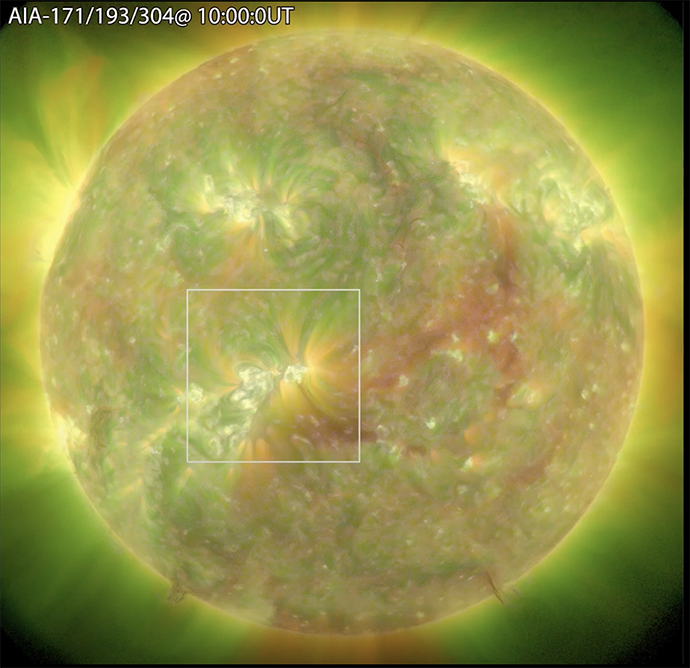On 3 March 2022, just a few months into Solar Orbiter’s nominal mission, the spacecraft’s Extreme Ultraviolet Imager (EUI) returned data showing for the first time that a magnetic phenomenon called reconnection was taking place persistently on tiny scales.
Adjunct Professor Guillaume Aulanier at RoCS comments on the phenomenon:
"This unprecedented observation now allows to argue that the same long-duration and continuous magnetic-reconnection process should occur in all low-coronal topological features,
not only null points as in this observation, but also quasi-separatrix layers. Since many of those are naturally present both in active regions and in the quiet Sun, as revealed by magnetic field extrapolations, as well as by recent analyses of simulations with the Bifrost code as achieved by Rebecca Robinson (who is completing her PhD at RoCS), the whole process ought to be ubiquitous and play a major role in the heating of our Sun's atmosphere."
At that time, the spacecraft was about halfway between the Earth and the Sun. This enabled coordinated observations with NASA’s Solar Dynamics Observatory (SDO) and Interface Region Imaging Spectrograph (IRIS) missions.The data from the three missions was then combined during the analysis.
Magnetic reconnection occurs when a magnetic field changes itself into a more stable configuration. It is a fundamental energy release mechanism in superheated gasses known as plasmas and is believed to be the major mechanism for powering large-scale solar eruptions. This makes it the direct cause of space weather, and a prime candidate for the mysterious heating of the Sun’s outer atmosphere.
It has been known since the 1940s that the Sun’s outer atmosphere, called the corona, is much hotter than the Sun’s surface. While the surface glows at around 5000°C, the corona is a rarified gas of around 2 million °C. How the Sun injects energy into its atmosphere to heat it to this tremendous temperature has been a major puzzle ever since.
In the past, magnetic reconnection has usually been seen during large-scale, explosive phenomena.
However, the new result presents ultra-high-resolution observations of persistent small-scale (around 390 km across) reconnection in the corona. These are revealed to be a long-lived ‘gentle’ sequence compared to sudden explosive releases of energy that reconnection is usually associated with.
The 3 March 2022 event took place over the period of one hour. The temperatures around the point of the magnetic field where the magnetic field intensity drops to zero, known as the null-point, sustained itself at around 10 million °C, and generated an outflow of material that came in the form of discrete ‘blobs’ travelling away from the null point with a speed of around 80 km/s.
In addition to this continuous outflow, an explosive episode also took place around this null point, and lasted for four minutes.
Solar Orbiter’s results suggest that magnetic reconnection, at scales that were previously too small to be resolved, proceeds continually in both gentle and explosive ways.
This is importantly because it means that reconnection can therefore persistently transfer mass and energy to the overlying corona, contributing to heating it.
These observations also suggest that even smaller and more frequent magnetic reconnections await discovery. The goal is now to observe these with EUI at even higher spatio-temporal resolution in the future around Solar Orbiter’s closest approaches to estimate what fraction of the corona’s heat may be transferred in this way.
Solar Orbiter’s most recent closest passage to the Sun took place on 10 April 2023. At that time, the spacecraft was just 29 percent the Earth’s distance from the Sun.
Solar Orbiter is a space mission of international collaboration between ESA and NASA, operated by ESA.
These results are published in Nature Communications in a paper titled Ultra-high-resolution Observations of Persistent Null-point Reconnection in the Solar Corona. Principal author Prof. Xin Cheng, Nanjing University, China, and Max Planck Institute for Solar System Research, Göttingen, Germany led an international team of 24 collaborators which included RoCS' Adjunct Professor Guillaume Aulanier.
Aulanier comments that "This unprecedented observation now allows to argue that the same long-duration and continuous magnetic-reconnection process should occur in all low-coronal topological features, not only null points as in this observation, but also quasi-separatrix layers. Since many of those are naturally present both in active regions and in the quiet Sun, as revealed by magnetic field extrapolations, as well as by recent analyses of simulations with the Bifrost code as achieved by Rebecca Robinson (who is completing her PhD at RoCS), the whole process ought to be ubiquitous and play a major role in the heating of our Sun's atmosphere."
RoCS on a mission with ESA and NASA
Solar Orbiter is a space mission of international collaboration between ESA and NASA, operated by ESA. It launched on 10 February 2020.
RoCS - Rosseland Centre for Solar Physics has been a part of the mission from the start and their scientists and engineers play key roles on one of the remote sensing instruments: SPICE (Spectral Imaging of the Coronal Environment).
